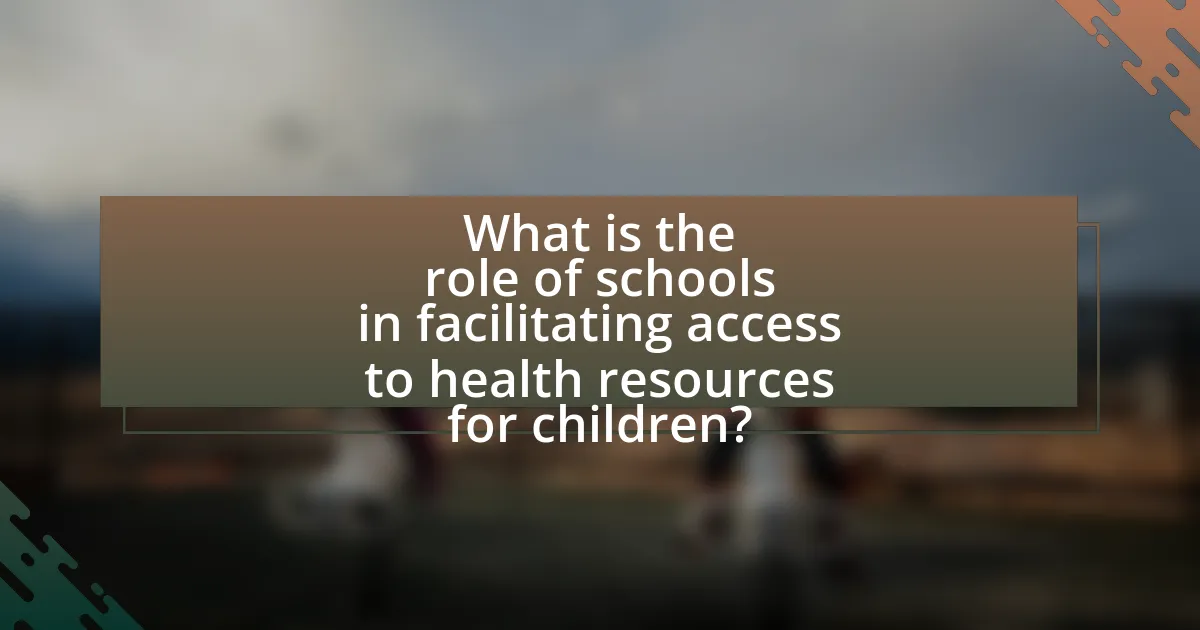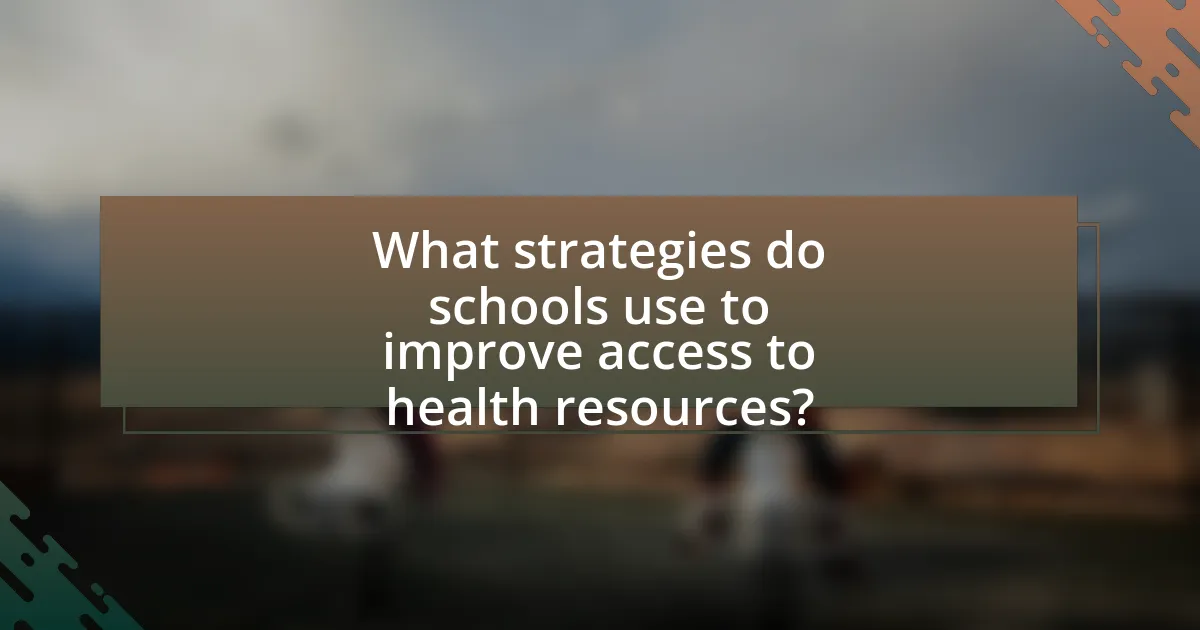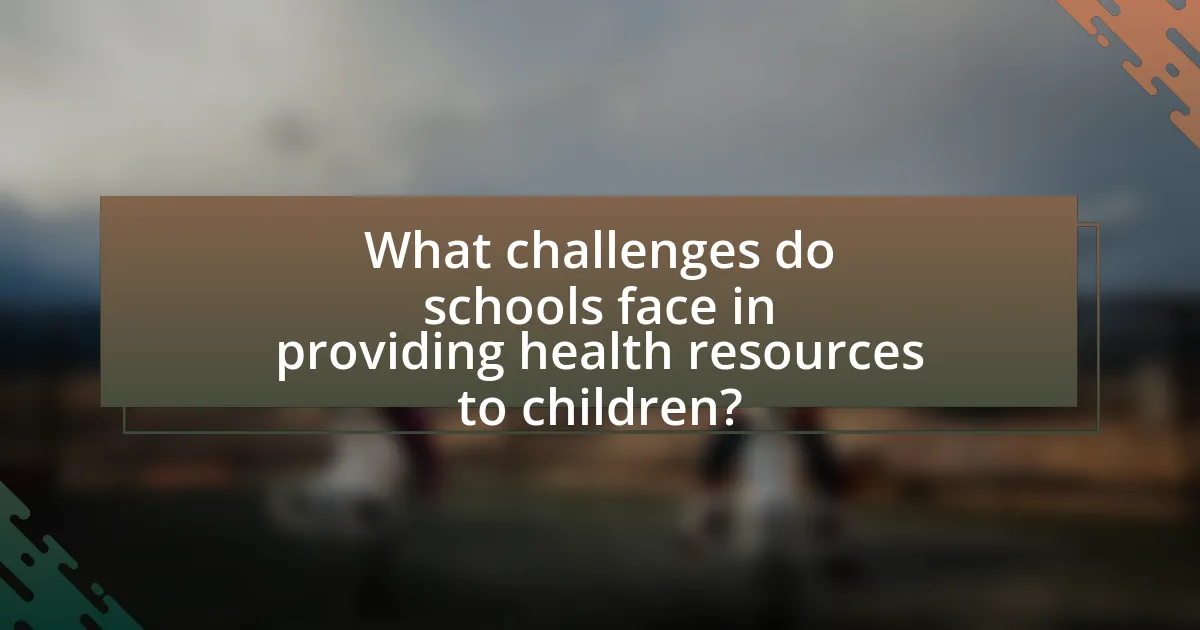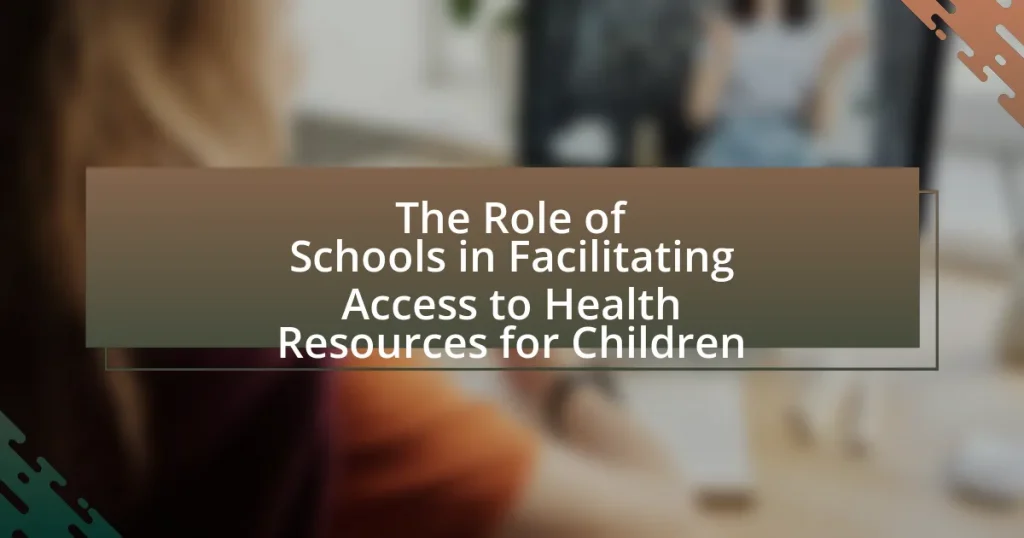The article focuses on the critical role of schools in facilitating access to health resources for children. It outlines how schools provide health education, on-site health services, and partnerships with community health organizations to support students’ physical, mental, and emotional well-being. Key components discussed include the availability of school nurses, mental health counselors, and nutrition programs, as well as strategies for identifying health needs and overcoming barriers to access. The article emphasizes the importance of these resources in enhancing academic performance and social development, while also addressing the challenges schools face in providing comprehensive health services.

What is the role of schools in facilitating access to health resources for children?
Schools play a crucial role in facilitating access to health resources for children by providing health education, on-site health services, and partnerships with community health organizations. Through health education programs, schools inform students about nutrition, physical activity, and mental health, which empowers them to make informed health choices. Additionally, many schools offer on-site services such as counseling, immunizations, and health screenings, which directly address students’ health needs. Furthermore, schools often collaborate with local health agencies to connect families with resources like health insurance and wellness programs, thereby enhancing overall access to necessary health services. This multifaceted approach ensures that children receive comprehensive support for their health and well-being.
How do schools contribute to children’s health and well-being?
Schools contribute to children’s health and well-being by providing access to nutritious meals, physical education, mental health resources, and health education. These elements are essential for fostering a healthy lifestyle among students. For instance, the National School Lunch Program ensures that millions of children receive balanced meals, which are crucial for their physical development and cognitive function. Additionally, physical education classes promote regular exercise, which is linked to improved physical health and reduced obesity rates among children. Schools also often have counselors and mental health programs that support emotional well-being, addressing issues such as anxiety and depression. Research indicates that students who participate in school-based health programs show improved academic performance and overall health outcomes, highlighting the significant role schools play in promoting children’s health and well-being.
What specific health resources are typically available in schools?
Schools typically provide health resources such as school nurses, mental health counselors, health education programs, and access to physical health services. School nurses are trained professionals who manage student health issues, administer medications, and provide first aid. Mental health counselors offer support for emotional and psychological well-being, addressing issues like anxiety and depression. Health education programs teach students about nutrition, physical activity, and overall wellness, promoting healthy lifestyle choices. Additionally, many schools partner with local health clinics to provide physical health services, including vaccinations and routine check-ups, ensuring that students have access to necessary medical care. These resources collectively contribute to the overall health and well-being of students, facilitating a supportive environment for their development.
How do schools identify the health needs of their students?
Schools identify the health needs of their students through comprehensive assessments, including health screenings, surveys, and collaboration with healthcare professionals. These assessments often involve collecting data on physical health, mental health, and social determinants of health, allowing schools to pinpoint specific health issues affecting their student population. For instance, the Centers for Disease Control and Prevention (CDC) recommends regular health screenings to monitor conditions such as obesity and asthma, which are prevalent among school-aged children. Additionally, schools may utilize anonymous surveys to gather information on students’ mental health and wellness, ensuring that they can address issues like anxiety and depression effectively. By analyzing this data, schools can develop targeted health programs and interventions that meet the specific needs of their students.
Why is access to health resources important for children in schools?
Access to health resources is crucial for children in schools because it directly impacts their physical, mental, and emotional well-being. Schools serve as primary environments for children, where they spend significant time, making it essential to provide health services that address their needs. Research indicates that access to health resources, such as counseling, nutrition programs, and medical care, leads to improved academic performance and better overall health outcomes. For instance, a study published in the Journal of School Health found that students with access to school-based health services had 20% higher attendance rates compared to those without such access. This demonstrates that health resources in schools not only support children’s immediate health needs but also contribute to their long-term educational success.
What impact does access to health resources have on children’s academic performance?
Access to health resources significantly enhances children’s academic performance. When children have access to healthcare, including regular check-ups, vaccinations, and mental health services, they experience fewer absences due to illness and better overall well-being. Research indicates that students with access to health resources demonstrate improved concentration, higher test scores, and better classroom behavior. For instance, a study published in the Journal of School Health found that schools providing health services saw a 20% increase in student attendance and a corresponding rise in academic achievement. This correlation underscores the critical role that health resources play in fostering an environment conducive to learning.
How does access to health resources influence children’s social development?
Access to health resources significantly influences children’s social development by promoting physical well-being, which is essential for effective social interactions. When children have access to healthcare, they are more likely to attend school regularly, participate in social activities, and develop friendships, all of which are crucial for social skills. Research indicates that children with better health outcomes exhibit higher levels of social competence and emotional regulation, leading to improved peer relationships and reduced behavioral issues. For instance, a study published in the Journal of School Health found that access to school-based health services positively correlates with students’ social engagement and academic performance, highlighting the integral role of health resources in fostering social development.

What strategies do schools use to improve access to health resources?
Schools implement various strategies to improve access to health resources, including establishing school-based health centers, integrating health education into the curriculum, and fostering partnerships with local health organizations. School-based health centers provide students with direct access to medical, dental, and mental health services, which has been shown to increase utilization of health services among students. Integrating health education into the curriculum equips students with knowledge about health issues and encourages healthy behaviors, contributing to overall well-being. Additionally, partnerships with local health organizations can enhance resource availability and provide specialized services, further supporting student health. These strategies collectively aim to create a supportive environment that prioritizes student health and well-being.
How do partnerships with health organizations enhance school health resources?
Partnerships with health organizations enhance school health resources by providing access to specialized knowledge, services, and funding that schools may lack. These collaborations enable schools to implement comprehensive health programs, such as mental health services, nutrition education, and physical health screenings, which are essential for student well-being. For instance, a study published in the Journal of School Health found that schools partnered with local health departments reported improved health outcomes and increased student engagement in health-related activities. This evidence demonstrates that such partnerships are crucial for expanding and improving the health resources available to students.
What types of health organizations typically collaborate with schools?
Health organizations that typically collaborate with schools include public health departments, non-profit health organizations, hospitals, and community health clinics. These organizations work with schools to provide health education, screenings, vaccinations, and mental health services. For instance, the Centers for Disease Control and Prevention (CDC) often partners with schools to implement health programs aimed at improving student health outcomes. Additionally, local health departments may offer resources and support for school-based health initiatives, demonstrating the collaborative efforts to enhance children’s access to health resources.
How can schools effectively manage these partnerships?
Schools can effectively manage partnerships by establishing clear communication channels and setting mutual goals with health resource providers. This involves regular meetings to assess the partnership’s progress and address any challenges, ensuring that both parties remain aligned in their objectives. Research indicates that schools that implement structured partnership frameworks, such as the one outlined in the “Partnerships for Health: A Guide for Schools” by the Centers for Disease Control and Prevention, see improved health outcomes for students. By actively engaging stakeholders, schools can foster a collaborative environment that enhances access to essential health resources for children.
What role do school health programs play in facilitating access to resources?
School health programs play a crucial role in facilitating access to health resources by providing comprehensive services that address physical, mental, and social well-being. These programs often include health education, screenings, and referrals to healthcare services, which help identify and meet the health needs of students. For instance, the Centers for Disease Control and Prevention (CDC) reports that schools with health programs can improve student health outcomes and academic performance by connecting students to necessary health services, thereby reducing barriers to access.
What are the key components of effective school health programs?
Effective school health programs consist of comprehensive health education, access to health services, a healthy school environment, and family and community involvement. Comprehensive health education equips students with knowledge about physical, mental, and social health, promoting informed decision-making. Access to health services ensures that students receive necessary medical care, including screenings and counseling, which is crucial for their overall well-being. A healthy school environment encompasses nutritious food options, physical activity opportunities, and safe facilities, all of which contribute to students’ physical health. Lastly, family and community involvement fosters a supportive network that enhances the effectiveness of health initiatives, as evidenced by studies showing that schools with strong community ties report better health outcomes among students.
How do these programs address the diverse health needs of students?
These programs address the diverse health needs of students by providing tailored health services that cater to various physical, mental, and emotional health requirements. For instance, schools often implement comprehensive health education curricula, mental health counseling, and access to nutrition programs, ensuring that all students receive appropriate support. Research indicates that schools with integrated health services report improved student well-being and academic performance, demonstrating the effectiveness of these programs in meeting diverse health needs.

What challenges do schools face in providing health resources to children?
Schools face significant challenges in providing health resources to children, primarily due to limited funding and inadequate staffing. Many educational institutions operate under tight budgets, which restrict their ability to hire qualified health professionals and maintain health programs. According to the National Association of School Nurses, approximately 25% of schools do not have a full-time school nurse, which directly impacts the availability of health services. Additionally, schools often struggle with a lack of access to comprehensive health education and resources, leading to gaps in students’ understanding of health issues. These challenges hinder schools’ ability to effectively promote and support the health and well-being of their students.
How do funding limitations affect access to health resources in schools?
Funding limitations significantly restrict access to health resources in schools by reducing the availability of essential services such as mental health counseling, health education, and preventive care. For instance, schools with inadequate funding often lack trained health professionals, leading to fewer health screenings and limited health education programs. According to a report by the National Association of School Nurses, schools with higher funding can employ more nurses and counselors, which directly correlates with improved student health outcomes. Consequently, funding constraints hinder the ability of schools to provide comprehensive health resources, ultimately affecting student well-being and academic performance.
What alternative funding sources can schools explore?
Schools can explore alternative funding sources such as grants from government agencies, private foundations, and corporate sponsorships. For instance, the U.S. Department of Education offers various grant programs aimed at enhancing educational resources, while organizations like the Robert Wood Johnson Foundation provide funding specifically for health-related initiatives in schools. Additionally, partnerships with local businesses can lead to sponsorship opportunities that support health programs and resources. These funding avenues not only supplement traditional funding but also enable schools to implement innovative health initiatives that benefit students.
How can schools prioritize health resource allocation despite budget constraints?
Schools can prioritize health resource allocation despite budget constraints by implementing strategic partnerships with local health organizations and leveraging community resources. These partnerships can provide access to additional funding, services, and expertise that schools may lack. For instance, a study by the Robert Wood Johnson Foundation found that schools collaborating with community health providers can enhance health services available to students without incurring significant costs. Additionally, schools can conduct needs assessments to identify the most critical health issues affecting their students, allowing them to allocate resources more effectively. By focusing on high-impact areas, such as mental health support and nutrition programs, schools can maximize the benefits of limited funding.
What barriers do students face in accessing health resources at school?
Students face several barriers in accessing health resources at school, including lack of awareness, limited availability of services, and stigma associated with seeking help. Many students are unaware of the health resources available to them, which can be attributed to insufficient communication from school administrations. Additionally, schools may not have adequate health services or staff to meet the needs of all students, leading to long wait times or unavailability of care. Stigma surrounding mental health and other health issues can further deter students from seeking assistance, as they may fear judgment from peers or staff. These barriers collectively hinder students’ ability to utilize essential health resources effectively.
How do cultural and social factors influence access to health resources?
Cultural and social factors significantly influence access to health resources by shaping individuals’ beliefs, behaviors, and interactions with healthcare systems. For instance, cultural norms may dictate attitudes towards seeking medical care, with some communities prioritizing traditional remedies over modern medicine, which can limit access to essential health services. Additionally, social determinants such as socioeconomic status, education level, and community support networks affect individuals’ ability to navigate healthcare systems and utilize available resources. Research indicates that marginalized groups often face barriers due to discrimination and lack of culturally competent care, further exacerbating health disparities. For example, a study published in the American Journal of Public Health found that low-income populations are less likely to receive preventive care due to financial constraints and limited access to information about available services.
What strategies can schools implement to overcome these barriers?
Schools can implement strategies such as establishing partnerships with local health organizations, integrating health education into the curriculum, and providing on-site health services to overcome barriers to accessing health resources for children. By collaborating with health organizations, schools can facilitate access to services like vaccinations and mental health support, which are crucial for student well-being. Integrating health education into the curriculum ensures that students understand the importance of health resources and how to access them. Additionally, providing on-site health services, such as school nurses or counseling, directly addresses health needs and reduces barriers related to transportation and awareness. These strategies have been shown to improve student health outcomes and increase utilization of health resources, as evidenced by studies indicating that schools with comprehensive health programs report higher student engagement in health services.
What best practices can schools adopt to enhance access to health resources?
Schools can enhance access to health resources by implementing comprehensive health education programs, establishing partnerships with local health organizations, and providing on-site health services. Comprehensive health education programs equip students with knowledge about nutrition, mental health, and physical well-being, which has been shown to improve health outcomes (CDC, 2020). Partnerships with local health organizations can facilitate access to screenings, vaccinations, and health information, thereby increasing community engagement and resource availability. Additionally, on-site health services, such as school nurses and counseling, ensure that students receive immediate care and support, which is critical for addressing health issues early and effectively.
How can schools engage parents and the community in health initiatives?
Schools can engage parents and the community in health initiatives by implementing collaborative programs that promote health education and awareness. For instance, schools can organize workshops and seminars that involve parents and community members, focusing on topics such as nutrition, physical activity, and mental health. Research indicates that parental involvement in school health programs leads to improved student health outcomes, as evidenced by a study published in the Journal of School Health, which found that schools with active parent engagement saw a 20% increase in student participation in health-related activities. Additionally, schools can establish partnerships with local health organizations to provide resources and support, further enhancing community involvement and access to health services.
What role does student feedback play in improving health resource access?
Student feedback plays a crucial role in improving health resource access by providing insights into the specific needs and preferences of students regarding health services. This feedback allows schools to identify gaps in existing health resources and tailor programs to better meet the needs of the student population. For instance, a study published in the Journal of School Health found that schools that actively solicited and implemented student feedback saw a 30% increase in student engagement with health services. By incorporating student perspectives, schools can enhance the effectiveness and accessibility of health resources, ensuring they are relevant and beneficial to the students they serve.
